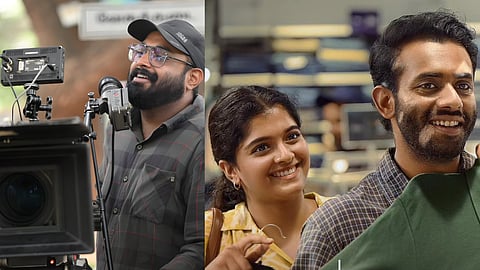

When Akhil Anilkumar’s Thalavara arrived on Prime Video recently, one of the first things viewers noticed was its restraint. Jyothish’s vitiligo, which could easily have been accentuated or aestheticised, is instead absorbed into the film’s texture without emphasis. That quiet choice reflects the ethic of its cinematographer, Anurudh Aneesh. “I believe cinematography should be invisible,” he says, adding, “Cinema is not cinematography. It is the script, the story, the journey of its characters.”
For him, the image is never meant to perform on its own. “If the cinematography stands out on its own or is praised in isolation without people actually enjoying the film, then it defeats the purpose,” points out Anurudh. It’s a conviction that feels innate, not performative, coming from someone whose debut as an independent cinematographer, Aattam, won three National Awards, including Best Film, last year. That success could have inspired self-consciousness in another, but for Anurudh, it has only reinforced his belief in invisibility.
Thalavara is an underdog drama that balances the breeziness of a small-town entertainer with a moral clarity at its core. Before discussing craft, Anurudh discusses temperature, which means the emotional charge of a scene, its softness or its abrasion, and the mood it carries. “I believe cinematography is like psychiatry. I think about how the audience should feel the film rather than just see it,” says Anurudh, who was insistent on getting the emotions right before the shot design. “There were no early discussions with Akhil about how to present Jyothish visually. Our first conversations were about the script and its emotions.”
Heaping praises on the performances, Anurudh says, “Even if we had shot it on a mobile phone, Arjun (Ashokan)’s performance would still have worked.” There was also a stark contrast between the visuals of Thalavara and Aattam. “Thalavara was easier because the locations were open and comfortable,” says the cinematographer, who shares that the rather different approach to the staging of the much-discussed romantic melody 'Ilakozhiye' was psychological rather than being ornamental. “I used lenses that isolate their world, unlike the wider perspective used throughout the rest of the film for Jyothish with his friends and family. Since the song is the couple's private romantic space, I used specific lighting to heighten its beauty.” For him, the distinction isn’t between ‘song’ and ‘film,’ but between the public self and the inner self.
Thalavara also marked his collaboration with acclaimed editor-turned-filmmaker Mahesh Narayanan, who presented the film. Their partnership, Anurudh notes, was one of conversations rather than hierarchy. “When we began discussing Thalavara, I told Mahesh chettan I had never done a comedy or a light film, and he said he had not either, and that is where we clicked (laughs). His contribution in direction makes my work easier because I know exactly what is required. He was busy with Patriot during the shoot of Thalavara, but whenever he came, his inputs were sharp and useful,” says Anurudh.
Then comes a remark that is disarming and radical for a cinematographer. “I sometimes feel cinema does not inherently require cinematography. If the script and the story are strong enough, even if you recorded it like a CCTV feed or like a well-staged play, it would still work. In short, cinematography should not overpower the film,” says a rather pragmatic Anurudh, who believes that not falling into any stereotype, enforced or assumed, is his yardstick for success. This pressure, he clarifies, is self-imposed and functions not as anxiety but as discipline.
This clarity began, like it did for many of his generation, with years of watching films before film school. The turning point arrived in adolescence. After watching Amal Neerad’s Big B in the tenth standard, he attempted his first short film over a summer break. Gradually, his attention narrowed to the power of the image. “I was especially inspired by Santhosh sir’s shots in Urumi and Raavanan. After that, I joined film school. The support from my family was uncertain at first, but they became convinced once I worked into Premam, assisting Anend C Chandran.”
From Premam, the path led to Aanandam, Helen, Pookkaalam, Aattam, and now Thalavara. Every film he has been part of, as an associate or independently, has either found success or triggered conversation. Alongside films, he continues to work in advertising, which he treats as a different craft rather than a lesser one. “In cinema, we have the space and time to build an image and reveal it gradually. In advertising, everything has to be delivered at once. Advertising frames can be glossy and stylish, but they do not have the same simplicity.”
He avoids an attachment to a fixed look and prefers a balance in which the image never speaks louder than the story. In a visual culture that rewards surfaces, he argues for a kind of supervised disappearance, where cinematography works quietly under the film’s skin. In Thalavara, that ethic is visible precisely because the film refuses to draw attention to its images.